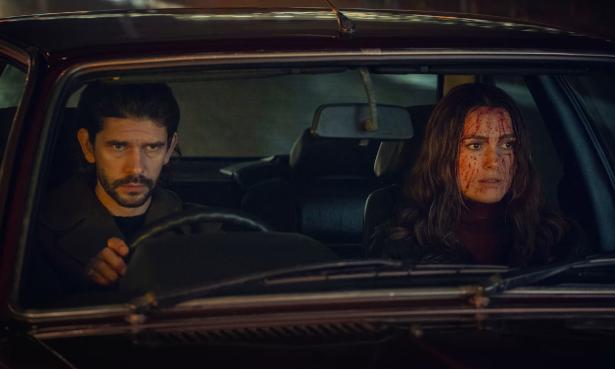Black Doves, starring Keira Knightley as a spy whose cover is about to be blown and Ben Whishaw as the hitman, mentor and confidant who comes to her rescue, goes off the rails after its impressive opening episodes. One element that remains consistent, however, is the show’s blasé approach to a type of character who would once have been treated as sidekick, comic relief or exotic pet: the gay best friend (GBF). No special song-and-dance is made about the sexuality of Whishaw’s character, Sam, whose opening scene proves that he applies the same precision techniques to both business and pleasure. Whether it’s a hook-up in a hotel bar or a target in his crosshairs, Sam gets his man. “I like that he’s just this queer guy who shoots people,” Whishaw told me.
Nor is Sam the only queer character in the series: there is also a smattering of snarky lesbian assassins. All of which would feel like tokenism were Sam and co not lively, vital creations with demonstrable social and sexual lives. Sam even has gay chums himself – yes, this GBF has GBFs of his own! – as well as an ex-boyfriend whose presence complicates the hitman’s work/life balance. None of this will be news to anyone familiar with the show’s creator, Joe Barton. Black Doves is cut from the same cloth as previous work such as Giri/Haji and The Bastard Son & The Devil Himself, which led to Barton being commended recently on social media for “consistently delivering slutty queer anti-heroes … That’s allyship!”
In writing Sam in Black Doves, Barton avoids all the pitfalls of the old GBF, who usually existed merely to make the straight protagonist look more interesting or compassionate by association. Or simply straighter. Think of I Love You, Man and Mrs Doubtfire, which each include a gay brother who fulfils the same purpose as the GBF: that is, to indicate to audiences that the main characters aren’t queer, whatever their behaviour (craving a bromance in the former movie, cross-dressing in the latter) might suggest.
The GBF has typically been allowed to be open about their sexuality so long as there aren’t any meaningful physical relationships in the offing. The assumption was that they had little-to-no existence when not providing succour for the protagonist, as James Coco does to Marsha Mason in the 1981 Neil Simon comedy Only When I Laugh. “Why don’t we get married?” asks Mason, to which Coco replies: “Because I’m gay and you’re an alcoholic and we’d have trouble getting our kids into a decent school.”
If GBFs did exist beyond those limits, their sexuality had to be in some way an issue or a narrative catalyst, as in the case of The Object of My Affection, which asks what might happen if a straight woman (Jennifer Aniston) got it on with her gay bestie (Paul Rudd). That film looks like the Citizen Kane of GBF movies beside The Next Best Thing, which used the same narrative template while trying to cash in on Rupert Everett’s work in My Best Friend’s Wedding, where he had been in full-on, rocket-fuelled, scene-after-scene-stealing GBF mode. The Next Best Thing paired him off with Madonna but neglected to give his character any traits beyond being gay.
GBFs have still been valuable in providing audiences with examples of queerness where none might otherwise exist. Rita Tushingham and Murray Melvin set a high bar for the straight woman/GBF relationship in the 1961 film of Shelagh Delaney’s A Taste of Honey. Where would Clueless be without the misguided desire of Cher (Alicia Silverstone) for her Spartacus-loving classmate Christian (Justin Walker)? And Scott Pilgrim vs the World was bold in its portrayal of the hero’s horny gay roommate, played by Kieran Culkin in a dry-run for his sardonic Roman Roy in Succession. The jury is still out on the matter of Duckie (Jon Cryer), best friend to Andie (Molly Ringwald) in Pretty in Pink. Ringwald has outed him in recent years, insisting that “Duckie doesn’t know he’s gay”. Cryer, though, has said: “I respectfully disagree … I want to stand up for all the slightly effeminate dorks that are actually heterosexual.”
Duckie’s time may have come: surely no one in our more fluid age would ask him to nail his colours to the mast. Times change. Campbell X’s 2012 film Stud Life offered a radically progressive portrait of queer friendship between a Black stud, or butch lesbian, and a gay white Jewish man. This year, Problemista challenged not only the former marginalisation of queer characters but also the very idea that queerness must in some way be synonymous with scale, colour, extravagance. The writer-director-star Julio Torres admitted he had made a film where the hero was someone who might ordinarily be considered “a secondary character”. Perhaps that’s the next big step for writers and directors to reckon with: that not all queer figures on screen need to slay or have main character energy. As Taylor Mac asked: “Must the tender queens be ‘fierce’ to chisel a place for themselves in the world?”
Narrating the 1995 documentary adaptation of Vito Russo’s seminal book The Celluloid Closet, Lily Tomlin observed that “the sissy made everyone feel more manly or more womanly by filling the space in between”. But when everything is fluid and up-for-grabs, there is no “space in between”. That space is everywhere now, as proven by Black Doves. We’re swimming in it.


Spread the word